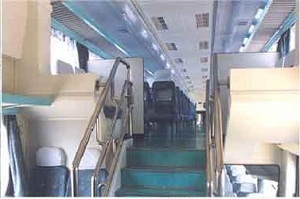
As a type of ideal medium and short-distance rail vehicle, the double-deck diesel multiple unit (DMU) was independently developed by Tangshan Rolling Stock Plant in 1998. The successful trial manufacture of this vehicle filled a blank of China in rail vehicle field. This double-deck DMU is equipped with imported engines and uses three-phase AC-DC drive mode; the vehicle features PLC control and is equipped with Siemens DC drive cabinets. TW160D independently driven power bogies and 209PK non power bogies are used. The profile of the whole train set features streamline design and attractive and decent styling. The designed formation is non-splittable (2 motor cars + 2 trailer cars). A large quantity of recently popular decorative materials for passenger cars are used on the train; design of semi-cushioned seat, cushioned seat, semi-cushioned berth, and cushioned berth is available upon customer request. Sliding-plug doors and fully-sealed diaphragms are used. The whole train is equipped with air conditioning equipment. Toilets, lavatories, etc. are also provided. A bar or buffet counter can be added in the middle upon customer request.
Divided into upper and lower decks, the double-deck DMU can be designed in the form of semi-cushioned seat coach, cushioned seat coach, semi-cushioned berth sleeper, or cushioned berth sleeper upon customer request with staircases (either circulatory or rotary) equipped between upper and lower decks. A toilet, electric apparatus room, crew room or public address room, etc. is provided at each of the 4 corners of each car. The whole train is air conditioned to make travel of passengers comfortable and cozy.
Cummins (U.S.A.) QST 30 serial products are used on the power system. Three-phase alternating current is generated by the main generator through coupling. Transformers and DC drive cabinets constitute a direct current system which, through voltage regulation, enables traction motor speed regulation thus allowing adjustment of running speed of the vehicle. The vehicle uses PLC control and 485 bus data transfer to achieve synchronization between leading and trailing cars.
TW160D power bogies and 209HS non power bogies are used on the DMU. All bogies are bolsterless. Car bodies are supported directly by air springs; zigzag draw bars are used for traction. Vertical and lateral as well as yaw dampers are equipped. The frame suspended traction motors drive wheel sets by means of one-stage gear drive. High-power electric connectors common to passenger cars are selected to allow duplicate supply. Electric communication and control connectors are installed at car ends. Fully enclosed or rubber diaphragms are used. Double circuit air supply is used for brake system. Color of exterior paint can be either customized or determined by the design work.
Specifications:
|
Purpose
|
Medium and short-distance passenger transport
|
|
Form of formation
|
2M+2T
|
|
Ambient temperature
|
-20℃~+40℃
|
|
Relative humidity
|
≤95%
|
|
Maximum grade on track
|
≤20‰
|
|
Height of platform
|
300-1100mm
|
|
Vehicle gauge
|
As per GBl46.1-83 Rolling stock gauge for standard gauge railways
|
|
Maximum running speed
|
120km/h
|
|
Starting acceleration
|
a≥0.23m/s2
|
|
Residual acceleration
|
a≥0.05m/s2
|
|
Emergency braking distance
|
<800m
|
|
Starting tractive effort
|
85kN
|
|
Total traction power
|
864kW
|
|
Riding index
|
W≤2.5
|
|
Overall coefficient of heat transfer of car body in stationary state
|
K<1.46w/m2.k
|
|
Noise (at 80km/h)
|
Driver’s cab ≤ 75dB(A); passenger saloon ≤ 68dB(A)
|
|
Overall length of EMU
|
105m
|
|
Seating capacity
|
540 (P)
|
|
Axle load
|
M car <18t; T car <17t
|